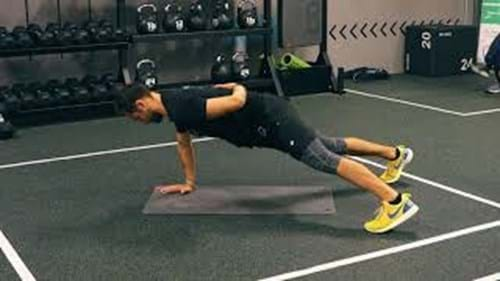One Arm Push Ups
What Is A One Arm Push Up?

Jump straight to the instructions
One arm push ups are a challenging bodyweight exercise that primarily target the muscles in the chest, shoulder, and arms. All the weight is placed on one arm as you lower your chest to the floor and push back up into a high plank position.
One arm push ups are much more challenging than conventional, two handed push ups. Not only is there more weight going through the one arm, but there is an additional need for stability, balance, spatial awareness, and control to keep the body stable during the push up. This asymmetrical movement not only engages the muscles of the chest, shoulders, and triceps but also activates the body's core and stabilising muscles. It can also help to reduce strength imbalances between the two sides as long as you start with your weaker side first.
One arm push ups are very advanced and it's generally recommended that you start by perfecting standard push ups, and then move on to other more challenging variations like decline push ups, medicine ball push ups, Spiderman push ups or diamond push ups, before you consider moving on to one arm push ups, or regressions like one arm knee push ups.
One arm push ups may be daunting at first, but with consistent practice and gradual progression, you'll be able to enjoy the strength and stability benefits of this demanding movement.
Check out some other push up variations: archer push ups, superman push ups, knee push ups, incline push ups, tricep push ups
Commonly Asked Questions On One Arm Push Ups
The number of one arm push ups that is considered 'good' can vary based on factors like age, sex, and fitness level. Being able to perform just one full one arm push up is an indication of good strength, but for intermediate lifters it's suggested around 11 is average.
One arm push ups are primarily a chest and tricep exercise, however they also engage multiple muscle groups throughout the body:
Chest (pectoralis major): The chest muscles are heavily engaged during the pushing phase of the one arm push up, helping you to lift your body.
Triceps brachii: The triceps, located at the back of the arms, support the extension of the elbow and help to lift the body. One arm push ups put much more weight on your arms than traditional push ups and require a lot more involvement from the triceps.
Shoulders (deltoids): The deltoid muscles, particularly the anterior (front) portion, are activated to stabilise and control the movement.
Core muscles: The core muscles, including the rectus abdominis, obliques, and transverse abdominis, are crucial for keeping you stable and preventing rotation as you lift and lower your body with one arm.
Scapular stabilisers (rhomboids and trapezius): The muscles around the shoulder blades (rhomboids and trapezius) are activated to stabilise the scapula and control the movement of the shoulder girdle.
Back muscles (latissimus dorsi): The latissimus dorsi muscles in the upper back support the stability of the shoulder joint during the one arm push up.
Serratus anterior: This muscle is involved in stabilising the shoulder blades against the ribcage.
When performed with correct technique, one arm push ups are effective at building upper body and core strength and stability.
One arm push ups are very challenging and it’s important to have good upper body and core strength and stability before attempting them. Begin with regular push ups (or incline push ups or knee push ups if you’re a total beginner), then move on to variations like wide push ups, deep push ups, decline push ups, diamond push ups, and Spiderman push ups. Once you're comfortable with these, you can start doing elevated one arm push ups and one arm knee push ups, and finally, one arm push ups.
One Arm Push Up Tips
Pay attention to the position of your hand and wrist. Ensure your wrist is strong and stable, and avoid excessive bending or twisting that could lead to discomfort or strain.
Choose a point to focus on during the exercise. This can help with balance and concentration. Keep your head in a neutral position to maintain a straight line from head to heels.
Coordinate your breathing with the movement. Inhale as you lower your body and exhale as you push back up. Controlled breathing can help you maintain stability and control.
To prevent muscle imbalances, train both arms equally. If one side is weaker, consider performing an extra set or additional repetitions on that side to address the imbalance.
Maintaining stability is crucial during one arm push ups. Engage your core and stabilise your shoulder blades to prevent excessive rotation or sagging. A strong and stable core helps control your body position throughout the movement.
How To Do A One Arm Push Up
Start in a plank position with your feet slightly wider than hip-width apart.
Spread your feet to create a stable base and keep your body in a straight line from head to heels.
Shifting your weight to your left side, rotate your body slightly and place your right hand behind your lower back or on your hip.
Slowly lower your body by bending your left elbow until your chest almost touches the floor.
Push through your left hand to extend your body up from the floor to the starting position, keeping your back straight.
Repeat the exercise with the other arm.
If you’re not sure if any of the above exercises are suitable for you, please consult your doctor before you start it. Need guidance on how to perform the exercise? Ask a personal trainer at your gym.